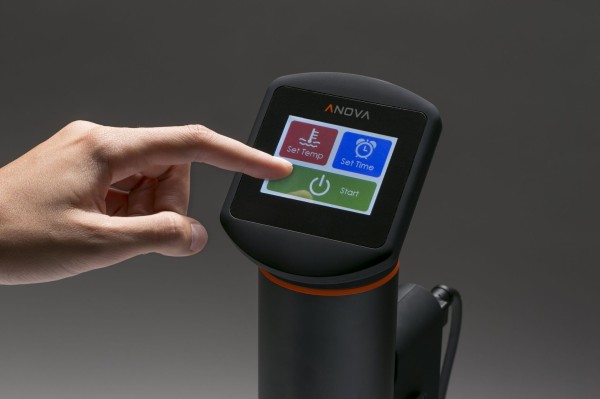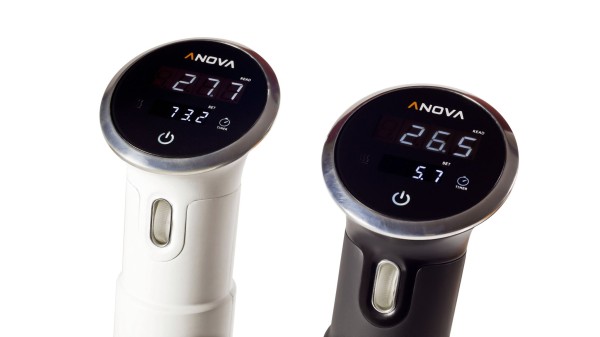Molecular gastronomy began as a scientific exploration of the chemical and physical processes of cooking, a scientist’s search for “the mechanisms of phenomena occurring during dish preparation and consumption”…an academic field driven more about “why” things taste the way they do versus the traditional “how” ingredients taste when prepared. Curious culinary talents like Rene Redzepi, Ferran Adrià, and Dave Arnold (whose food+tech blog, Cooking Issues, dazzles like his fine cooking) quickly realized the formal discipline of food science – and the tools at their disposal – could greatly expand their repertoire, revolutionizing haute cuisine beyond the pan and deep into the laboratory.
By hacking and utilizing an array of cool sounding contraptions like heated baths, rotary evaporators, anti-griddles, and thermal immersion circulators modernist cuisine chefs ventured into new frontiers where taste, texture, and the molecular state of ingredients are manipulated to expand the sensory experience of food. Unsurprisingly, some of the form-follows-function mad scientist machines used in the revolutionary cooking science are now trickling down into the home kitchen, with a few promising countertop sized, user-friendly smart kitchen tools available today and beyond…
Mellow: sous-vide is a method of gently cooking sealing food inside airtight plastic bags and placing them into a temperature-controlled water bath or steam environment usually for for 24-72 hours. The resulting delicate texture and flavorful taste is achievable because of the 20 lbs of pressure per square centimeter and slow cooking duration, both which aid in keeping flavor and moisture intact.
Current machines range from unwieldy industrial appliances to others appearing to be cobbled together by would-be Doc Browns. Mellow aims to change all that.
Introduced as a “kitchen robot“, the Mellow is a smart, learning countertop cooker which aims to simplify sous-vide cooking into a single button (or rather, smartphone tap) affair, further simplifying the cooking technique with real-time feedback, remote start/stop controls via iOS or Android app, and a continual monitoring system which adjusts settings to according to a home chef’s preferences. Impressively, Mellow can keep foods cool at refrigerator temperatures as well as heat food for cooking, meaning dinner could be dropped into the Mellow in morning, scheduled to cook before leaving work, and timed to finish as you arrive back home.
Anova: Where the Mellow is a self-contained sous-vide machine, the Anova Sous Vide Immersion Circulator is designed as a more adaptable kitchen tool capable of being dropped into a wide array of cooking equipment. At just $199 the touchscreen equipped, stick-style sous-vide circulator clamps onto pots or any large container to heat water to a precise temperature, with cooking times ranging from a 20 minutes (fish) to several days (confit).
The Anova has earned glowing praise as an affordable gateway device into the realm of molecular gastronomy style technique for its ease of use and sturdy construction, but currently lacks remote app controls and programming.
THINGK GK Series: comprised of the GKILO, a wood-like kitchen scale, and CLOGK, a timer with touch interface, this tandem of kitchen tools for the Internet of Things disguises Arduino-powered app integration into minimalist designs well suited for a futurist kitchen.
The dual function GKILO works as an ingredients scale on one side, and when flipped over operates as clock and timer. And since cook’s hands are often dirty, the designers equipped the GKILO with gesture control for hands-off resetting the scale or adjust the time. The sidekick CLOGK is a wireless, app-connected kitchen clock and timer. Features are a bit sparse, but the Italian based team of THINKG imagine expanding utility and integration with future wireless modules, alongside keeping the GK Series open-source for user modification and hacking.
Capsul8 Automatic Algin Spherizer: One of the signature techniques in the molecular gastronomy repertory is using sodium alginate, a natural gelling agent taken from the cell walls of certain brown seaweed species, and using it as a thickening agent for the creation of foams, sauce, and most dramatically, forming gelled “caviar”.The technique can be arduous when attempting consistency, each droplet sphere requiring a steady hand with a syringe.
Designer Jake Bjeldanes’s concept is designed to circumvent the need for manual labor and make algin spherizing as simple as using one of those battery powered pepper grinders. An electromechanical solenoid valves mechanism is designed to pop out consistent sized spheres to be dropped into a calcium bath for precise spherification.
What do you think? Would you use any of these devices in your kitchen?
























